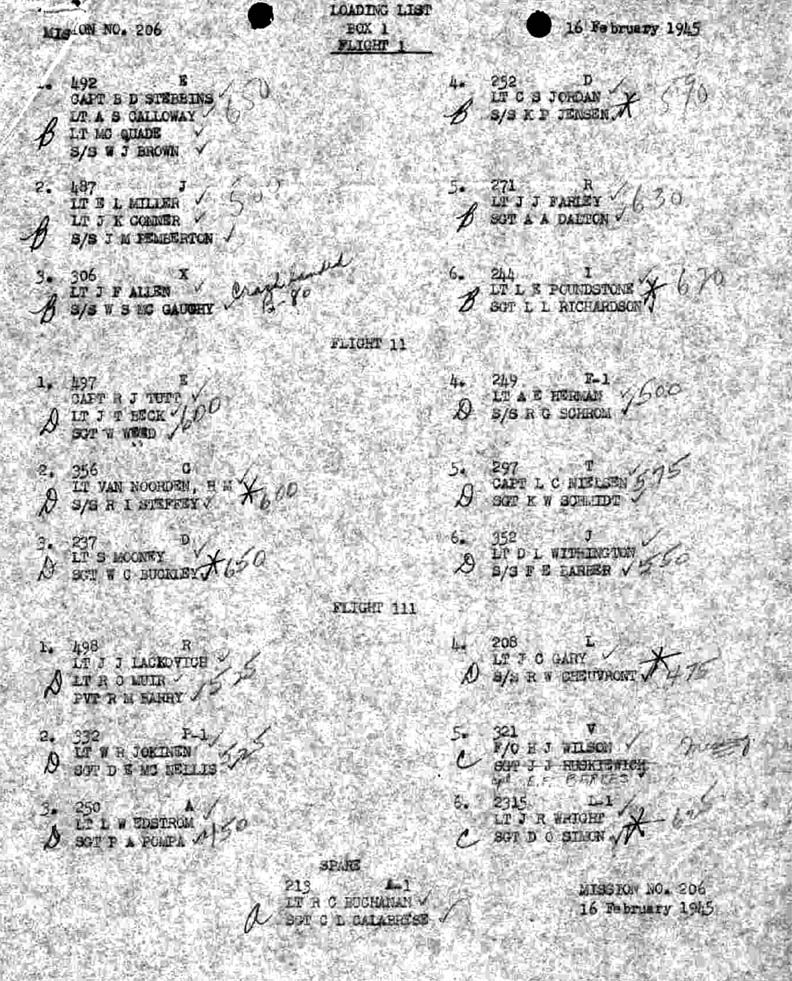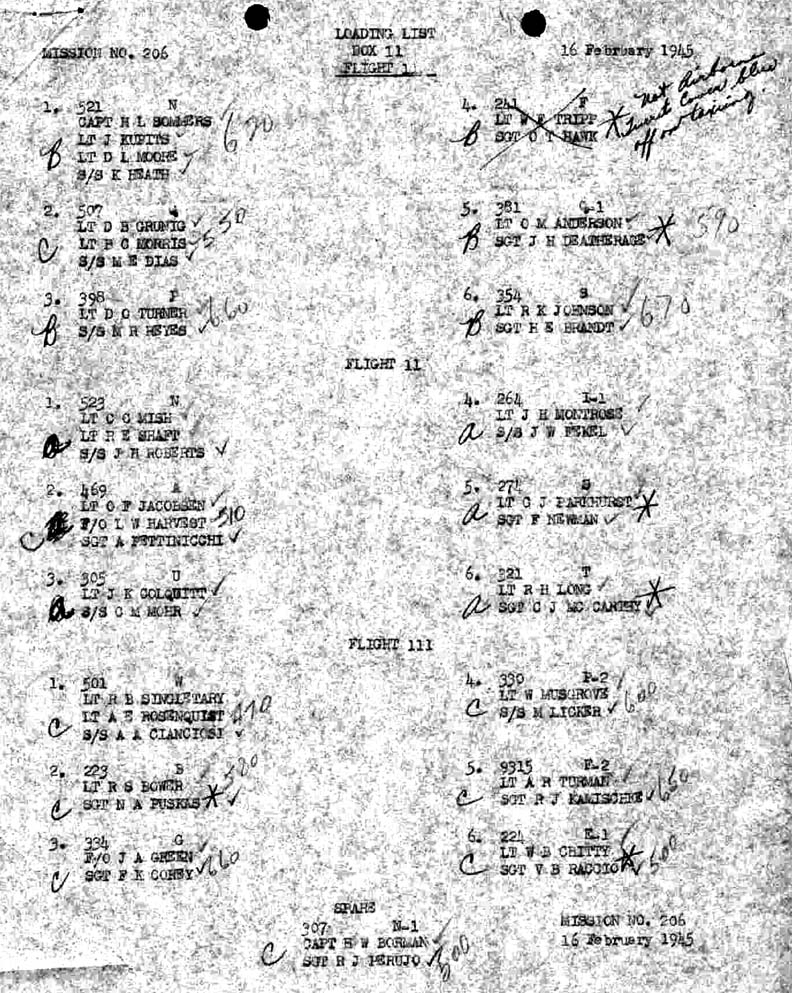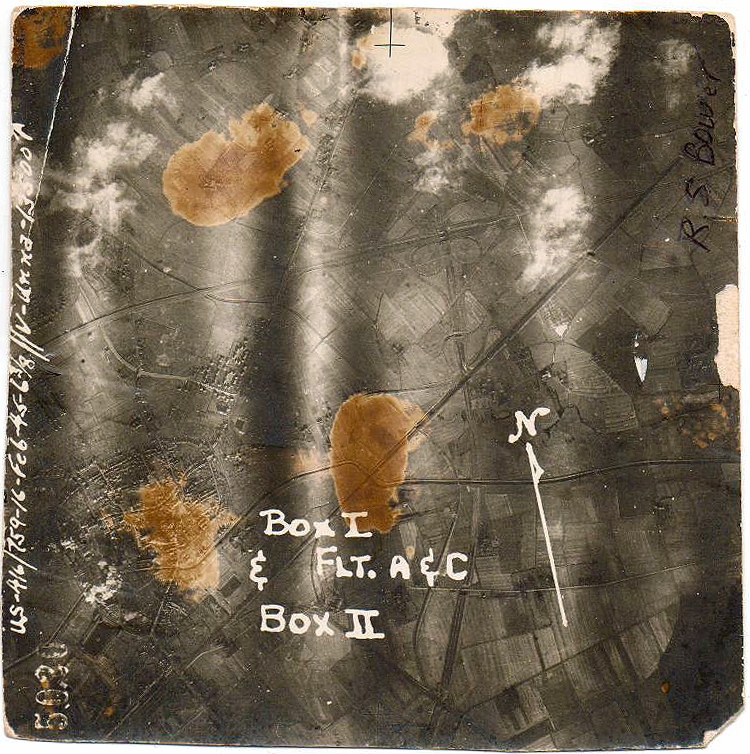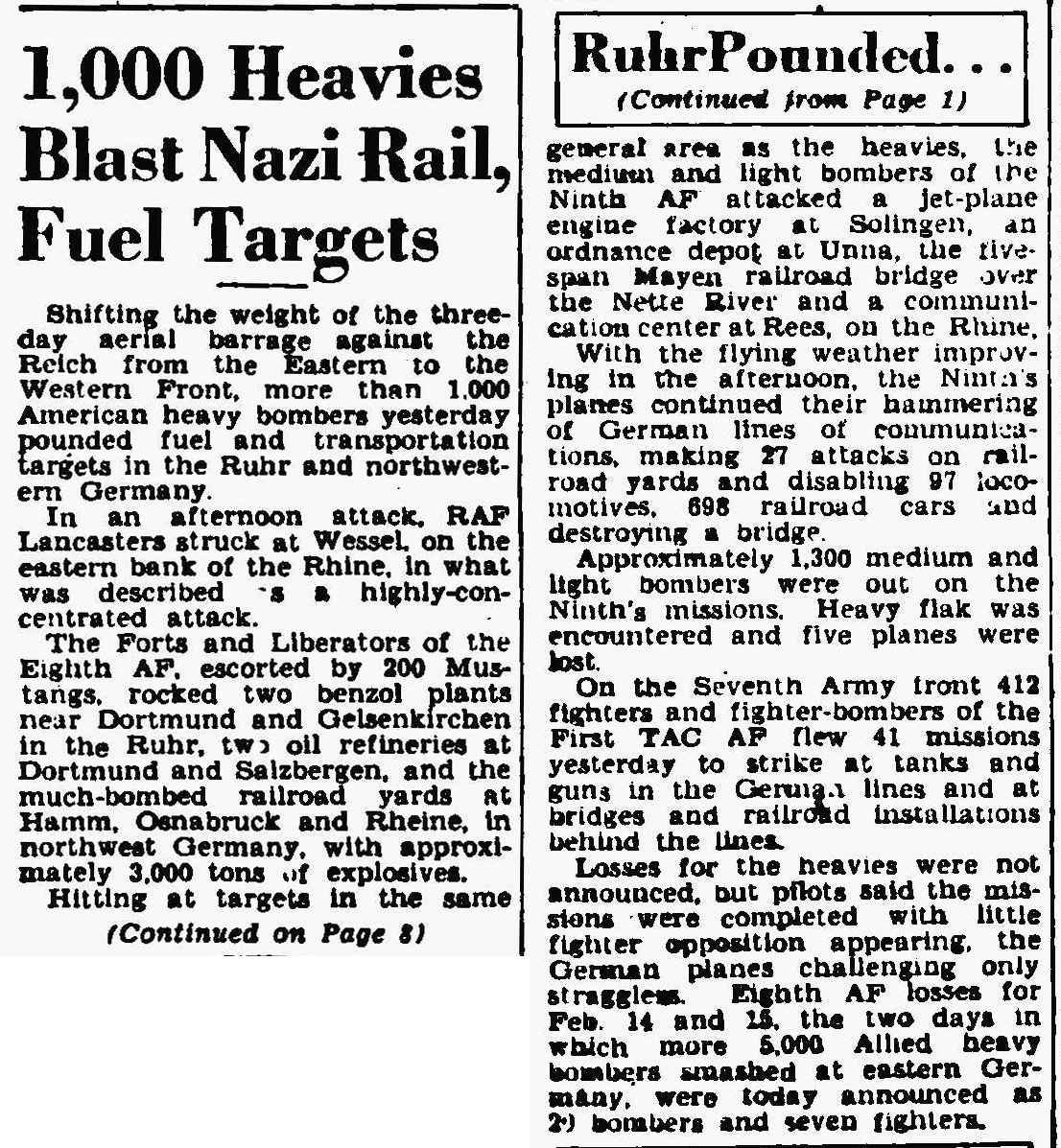 |
416th Bombardment Group (L) Mission # 206 -- February 16, 1945, Friday AM Unna, Germany Ordnance Depot
|
 |
Previous Mission # 205 Mission List Next Mission # 207 Return to Table of Contents
 |
416th Bombardment Group (L) Mission # 206 -- February 16, 1945, Friday AM Unna, Germany Ordnance Depot
|
 |
Place of Take-Off : A-69 Laon/Athies, France A/C Dispatched : 38 Total -- 37 A-26's, 1 B-26 (PFF) Modified British System Reference: A-966298 Secondary Target : Selected in accordance with IX Bomb Div Cipher F-576-E (9-2-45) Summary of Results : Unobserved. 28 A-26 a/c bombed Primary, 6 attacked Town of Unna (Casual), 1 Dortmund (Casual) and 1 Billmerich (Casual). Primary Target Latitude/Longitude: 51.56685,7.68817 (51° 34' 1" N, 7° 41' 17" E) (Latitude/Longitude based on The "Coordinates Translator", (NGZ) rA966298) (See Latitude/Longitude Coordinates and Target Identifiers for more information. Note: This coordinate represents the Primary Target Location, the Location actually attacked may differ) |






"Air Medal Day" from Lt. Robert S. Bower Combat Journal
"Today Capt Borman, Lt Chitty and myself really earned our Air Medal. We had a deep penetration today so we had a P47 escort. We entered Germany north of the Ruhr Valley and turned south to our target. Boy what a ride that was. I really believe that they had the master sergeants on the guns today. The flak was very, very intense and accurate. Everywhere I looked I saw flak. The sky just seemed to be filled with the lethal stuff. One curtain of it was so heavy it seemed like someone took a black crayon and colored out the blue sky. We encountered flak for about 15 minutes before we hit the target, over the target and about 5 minutes after we left the target. Capt. Bormans gunner counted 250 bursts. My gunner called me and said "Wow, you should see the flak back here". For my part I had all the flak in front of me that I ever want to see or even hear about. On our left turn off the target around Kamen, a heavily defended city, we caught so much flak, I thought the navigator had taken us over the town.
I'm sorry to say that the flak took it's toll. Some of the boys saw two B-26's go down and one A26 exploded. There is no such thing as a glorious part of combat. One of our A-26's had the canopy and bullet proof glass shot away. Many of the planes were shot up quite badly. Luckily only one plane in our flight was hit.
Our flight leader, Lt. Bob Singletary, Really led us in some violent evasive action. It was the most violent formation I have ever had to fly. We followed him into very steep turns, dives and climbs. His evasive action was jerky and sudden. Had it not been for such violent evasive flying I am sure we would all have had it."
| Date | Report | A/C Serial # Type |
Mis- sion # |
Bomb Sq |
Location | Personnel (Status when available) | |
|---|---|---|---|---|---|---|---|
| Feb 16, 1945 Friday |
No_Report | 43-22306 A-26B |
206 | 669 | B-80 | Allen, Julian F. Jr. (Not Injured)
McGaughy, William S. (Not Injured) |
|
| Feb 16, 1945 Friday |
MACR 12448 |
41-39321 A-26B |
206 | 671 | Kamen Area, Germany | Wilson, Harold James (MIA, KIA)
Berkes, Earl Fredrick (MIA, POW, RMC, EUS) |
Mission Loading Lists Transcription
Mission # 206 -- February 16, 1945, Friday AM
Unna, Germany -- Ordnance Depot
| 1 669th 43-22492 2A-E A-26C Capt Stebbins, B.D. Lt Calloway, A.S. Lt McQuade, R.J. S/Sgt Brown, W.J. |
2 669th 43-22487 2A-J A-26C Lt Miller, E.L. Lt Conner, J.K. S/Sgt Pemberton, J.M. |
3 669th 43-22306 2A-X A-26B Lt Allen, J.F., Jr. S/Sgt McGaughy, W.S. [Crash landed B-80] |
| 4 669th 41-39252 2A-D A-26B Lt Jordan, C.S. S/Sgt Jensen, K.F. |
5 669th 41-39271 2A-R A-26B Lt Farley, J.J. Sgt Dalton, A.A. |
6 669th 41-39244 2A-I A-26B Lt Poundstone, L.E. Sgt Richardson, L.L. |
| 1 671st 43-22497 5C-E A-26C Capt Tutt, R.J. Lt Beck, J.T. Sgt Wood, W.D. |
2 671st 43-22356 5C-C A-26B Lt VanNoorden, H.M. S/Sgt Steffey, R.I. |
3 671st 41-39237 5C-D A-26B Lt Mooney, S. Sgt Buckley, W.C. |
| 4 671st 41-39249 5C-F A-26B Lt Herman, A.E. S/Sgt Schrom, R.G. |
5 671st 41-39297 5C-T A-26B Capt Nielsen, L.C. Sgt Schmidt, K.W. |
6 671st 43-22352 5C-J A-26B Lt Withington, D.L., III S/Sgt Barber, F.E. |
| 1 671st 43-22498 5C-R A-26C Lt Lackovich, J.J. Lt Muir, R.C. Pvt Barry, R.M. |
2 671st 41-39332 5C-P A-26B Lt Jokinen, W.R. Sgt McNellis, D.E. |
3 671st 41-39250 5C-A A-26B Lt Edstrom, L.W. Sgt Pompa, P.A. |
| 4 671st 41-39208 5C-L A-26B Lt Gary, J.C. S/Sgt Cheuvront, R.W. |
5 670th 41-39321 F6-V A-26B F/O Wilson, H.J. Cpl Berkes, E.F. |
6 670th 43-22315 F6-L A-26B Lt Wright, J.R. Sgt Simon, D.O. |
| SPARE 668th 41-39213 5H-A A-26B Lt Buchanan, R.C. Sgt Calabrese, C.L. |
| 1 669th 43-22521 2A-N A-26C Capt Sommers, H.L. Lt Kupits, J. Lt Moore, D.L. S/Sgt Heath, K. |
2 670th 43-22507 F6-Q A-26C Lt Grunig, D.B. Lt Morris, B.C. S/Sgt Dias, M.E. |
3 669th 41-39398 2A-P A-26B Lt Turner, D.O., Jr. S/Sgt Reyes, M.R. |
| 4 669th 41-39241 2A-F A-26B Lt Tripp, W.F., Jr. Sgt Hawk, O.T. [Not Airborne Turret Cover blew off on taxiing] |
5 669th 43-22381 2A-Q A-26B Lt Anderson, C.M. S/Sgt Deatherage, J.H. |
6 669th 43-22354 2A-S A-26B Lt Johnson, R.K. S/Sgt Brandt, H.E. |
| 1 668th 43-22523 5H-N A-26C Lt Mish, C.C. Lt Shaft, R.E. S/Sgt Roberts, J.H. |
2 670th 43-22469 F6-A A-26C Lt Jacobsen, O.F. F/O Harvest, R.W. Sgt Pettinicchi, A. |
3 668th 41-39305 5H-U A-26B Lt Colquitt, J.K. S/Sgt Mohr, C.M. |
| 4 668th 41-39264 5H-I A-26B Lt Montrose, J.H. S/Sgt Felkel, J.W. |
5 668th 41-39274 5H-S A-26B Lt Parkhurst, G.J. Sgt Newman, F. |
6 668th 43-22321 5H-T A-26B Lt Long, R.H. Sgt McCarthy, C.J. |
| 1 670th 43-22501 F6-W A-26C Lt Singletary, R.B. Lt Rosenquist, A.E. S/Sgt Cianciosi, A.A. |
2 670th 41-39223 F6-B A-26B Lt Bower, R.S. Sgt Puskas, N.A. |
3 670th 43-22334 F6-G A-26B F/O Green, J.A. Sgt Corey, F.E. |
| 4 670th 43-22330 F6-P A-26B Lt Musgrove, W. S/Sgt Licker, M. |
5 670th 41-39315 F6-F A-26B Lt Turman, A.R. S/Sgt Kamischke, R.J. |
6 670th 41-39224 F6-E A-26B Lt Chitty, W.D., Jr. Sgt Raccio, V.B. |
| SPARE 670th 43-22307 F6-N A-26B Capt Borman, H.W. Sgt Perujo, R.J. |
Group and Unit Histories
Mission # 206 -- February 16, 1945, Friday AM
Unna, Germany -- Ordnance Depot
"416th Bombardment Group (L) - Group History 1945"
Transcribed from USAF Archives
The ordnance depot at Unna was the target on the 16th. Moderate to intense accurate flak followed the planes on their bomb run, over the target, and on the turn-off. The most intense flak seemed to be coming from Dortmund and Hamm. The PPF plane was hit by flak and dropped on the town of Kamen, two miles NW of the primary target, with excellent results. One flight, realizing that the PPF plane was dropping early, tried to pick up the target alone. A thick haze prevented their recognizing it. They bombed the town of Kal Kaiserau with excellent results. Going in on the bomb run, the plane flown by F/O H.D. Wilson, with Sgt E.F. Berkes gunner, was seen to nose up and then start downward, still under control. It went into the clouds at 6,000 feet and has not been heard from since. At about the same time, Lt J.F. Allens plane received a hit in his engine. The engine went dead. He continued with the formation on single engine but was forced to salvo his bombs before the target and started back alone. He flew north to clear the Rhine Valley and called for a heading home. A voice over the radio told him that he was in friendly territory. Just then, about 20 bursts of flak came up off his tail. He headed west until he found what looked to be a friendly airfield and started to circle it. Not until he heard what sounded like a German accent did he realize how close he was to more danger. Finally, a British fighter field contacted him and led him in. He landed safely. There, he was told that he had been flying through some of the "hottest" flak areas in that section. He also learned that the Germans had been trying, unsuccessfully, for some time to cut in on radio communications. Capt Stebbins, Lt Calloway B-N, and Capt Sommers, Lt Kupits, B-N, led the two boxes.
"Attack Bombers, We Need You! A History of the 416th Bomb Group"
Ralph Conte
Page 209
Mission #206 - 16 February - Unna Ordnance Depot. Captain
Stebbins and Lt. Calloway BN and Captain Sommers with Lt.
Kupits, BN led boxes. Captain Tutt with BN Lt. Beck, and Lts.
Lackovich and Muir, BN, - Lts. Mish and Shaft, BN and Lts.
Jacobsen and F/O Harvest BN, led flights. The PFF plane took a
hit losing his sighting on the primary target and bombed the town
of Kamen with excellent results. Other flights hit alternate targets.
Intense flak hit planes. F/O W. D. Wilson and Sgt. E. F.
Berkes went down after their plane nosed up. No chutes were
seen to blossom, although Sgt. Berkes was listed as having been
returned to military command. This was Wilson's eighth mission.
He had encountered bad luck on previous missions, and performed
exceedingly well under trying circumstances in the past.
Lt. Beck, BN, figured out the lead planes were not hitting the primary
targets, so he turned toward the town of Kid Kaiseran and
dropped his bombs there with good results.
Lt. J. F. Allen had one engine knocked out of service, but
he continued on to the target, dropping his bombs. He then headed
west, asking for a homing. He received a message that he was
over friendly territory and to continue on. He flew right into a
heavy concentrated barrage from 20 flak guns. He almost landed
at an airfield, which he thought was in allied hands. He heard a
German accent on the transmission and realized that was the
wrong place to go. A radio contact from a British Air Field gave
him a heading to safety. When he landed at that field, he was told
he flew into one of the most heavily defended flak emplacements
in the area where he was lured to go. Luckily, he made it out
okay.
"669th Bombardment Squadron (L) History"
Transcription from USAF Archives
Capt. Stebbens and Lt. Calloway led Box I while Capt. Sommers and Lt. Kupits led box II in an attack on the Unna Ordnance Dept on the 16th of the month. PPF technique was employed.
"670th Bombardment Squadron (L) History"
Transcription from USAF Archives
Three members of the 30th Infantry Division arrived from the front
on 15 February as the first of similar groups which were to come to
visit us on air-ground liaison work. They were Capt Arne Nielson, 1st
Lt James F. Taylor and T/Sgt Sterling. They were to stay with us for
about ten days and observe the Air Corps at work.
Lt Hall, Lt Rogers, S/Sgt Burger and S/Sgt Ottaviano left for the
front on 16 February for temporary duty in air-ground liaison work.
The Unna Ordnance Depot was hit with undetermined results on 16
February. Eight 670th crews took part. Moderate to intense heavy
accurate flak was met at the target and on the turnoff. One plane from
the formation went down.
"671st Bomb Squadron (L) Unit History"
Gordon Russell and Jim Kerns
February 16th, 1945
Covering up for the Eighth Air Force which was bombing in support of the Russian Army marching toward Berlin, the Ninth Bomb Division sent its forces into the flak congested Ruhr Valley on February 16th, 1945. Ordinarily a hot spot for the heavies at 20 to 30 thousand feet, the medium altitude Marauders and Invaders stuck their chins way out in going in a 12 thousand feet.
The Invaders of the 409th and 416th Groups and two Marauder outfits drew the roughest assignment...the Ordnance Depot at Unna, 11 miles east of Dortmund. This depot supplies the Western Front with large quantities of equipment, from guns to field kitchens. Three A-26s from the 409th went down over the target and on Marauder of the 386th Group was lost to flak. The 416th got more than its share of flak also. The pathfinder leading the formation was hit by flak in the right outboard fuel tank about three minutes before bombs away. Although it was losing fuel the B-26 led the formation over the target, bombed, and then led the formation back to the bomb-line. It was still under control at this point, but left the formation, and as no word has been received it is believed that the ship crashed. An A-26 from the 669th Squadron crash landed, but the crew was uninjured.
Continue on the next page.
F/O Wilson and his gunner, Sgt.Berkes of the Squadron were last seen going into a cloud at 6,000 after bombs away. No one saw the ship go down or even in trouble. However, the plane did not return and the crew is listed as missing in action. F/O Wilson had made quite a reputation for himself since joining the Squadron a short time ago. He won praise for his strafe/bombing attack on the vehicle concentration retreating from the Bulge on January 23rd . He crash landed away from base on his first mission and had several other trying experiences ranging down to a forced landing in the Cub. This was F/O Wilson's eight mission, most of which were rough.
The Pathfinder aircraft was unable to make a correct run on the Primary after receiving the flak hit, but picked the town of Kamen, 2 miles NW of the primary. Flight A and C of Box I and all of Box II dropped on the PFF. The bombs fell in scattered pattern in a section of the city, hitting buildings and roads. Captain Tutt and Lt.Beck were leading the second flight of the First Box. Lt. Beck realized the PFF was not bombing the primary, and he had insufficient time to get correct course to bomb Unna. He picked the casual town if Kid Kaiseran, 3 miles west of the primary. The bombs from thes 671st flight dropped in good pattern with hits on road junction at the edge of the town, probably cutting the roads.
Twenty-three aircraft of the formation received battle damage.
"671tst Bombardment Squadron (L) History"
Transcribed from USAF Archives
One of the first missions to take off from the new field proved to be one of the most costly for the squadron. While attacking an ordnance depot at Cenna, Germany, the Group encountered intense accurate flak which damaged at least twenty three aircraft of the formation. Flight Officer Wilson has not returned from this mission. No one has any knowledge as to where or when he may have been hit or how seriously the aircraft may have been damaged.

|
[February 16, 1945], HQ Twelfth Army Group situation map Map showing Western Allies and Axis troop position details in Western Europe as of approximately 1200 hours, February 16, 1945 World War II Military Situation Maps Collection Library of Congress |